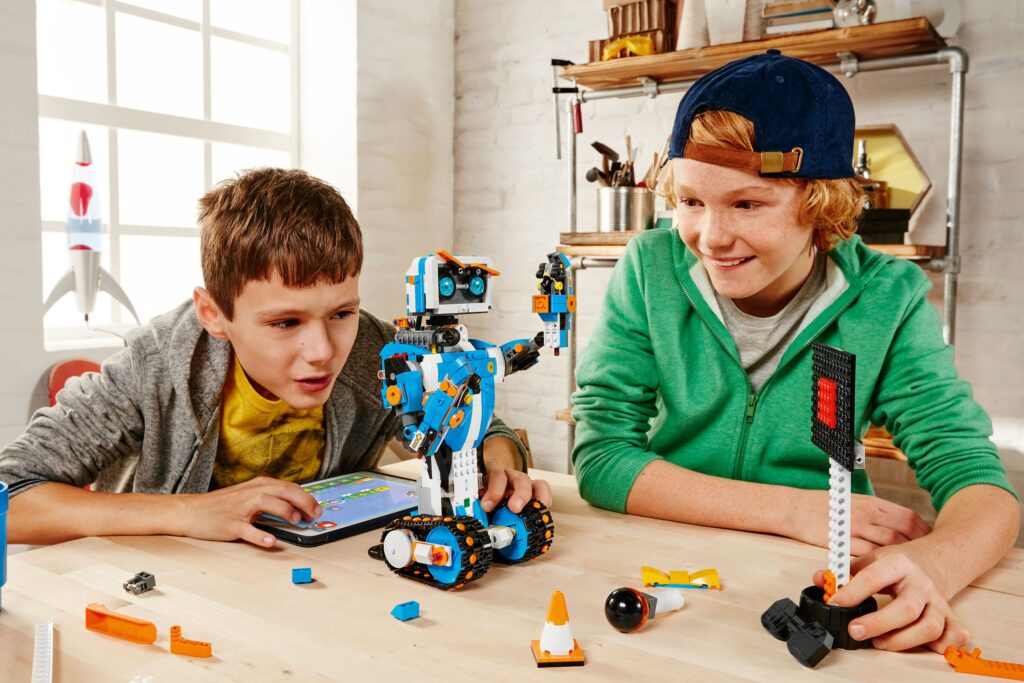Introducing children to Robotics for kids opens up a world of creativity, problem-solving, and technological exploration. Engaging in robotics activities not only cultivates valuable STEM skills but also fosters a sense of curiosity and innovation from an early age. In this guide, we’ll delve into some exciting projects and playful activities that make learning robotics a thrilling adventure for kids.

Top Robotics Resources for Kids
Shard Center for Innovation presents a curated selection of top robotics resources tailored for kids, fostering an engaging and educational journey into the world of robotics. Our offerings blend fun with learning, encouraging children to explore, create, and innovate through robotics:
Robotics Kits: Explore hands-on robotics kits designed specifically for children, offering various levels of complexity to suit different ages and skill levels. These kits come with easy-to-follow instructions and components that enable kids to build their robots.
Workshops and Classes: Enroll in workshops and classes conducted by experienced instructors who specialize in teaching robotics for kids. These sessions provide opportunities for children to collaborate, problem-solve, and unleash their creativity in a supportive environment.
Robotics Competitions: Participate in robotics competitions and challenges where kids can put their skills to the test and showcase their innovative creations. These events promote teamwork, critical thinking, and sportsmanship while fostering a spirit of healthy competition.
At Shard Center for Innovation, we believe that robotics education empowers children to become future innovators and problem solvers. Our top robotics resources aim to spark curiosity, ignite passion, and nurture the next generation of roboticists.
Build Your Bot: Kickstart the robotics journey by building a basic robot from scratch. Using materials like cardboard, motors, wheels, and sensors, kids can design and construct their own robots. Encourage experimentation and creativity as they explore different shapes, sizes, and functionalities. Whether it’s a simple wheeled robot or a more complex humanoid design, the act of building instills hands-on engineering skills and sparks imagination.
Coding Challenges: Introduce kids to coding through fun and interactive challenges. Platforms like Scratch, Blockly, or even simple coding languages like Python can be used to program robot behaviors. Start with basic commands like moving forward, turning, and stopping, then progress to more advanced concepts like loops, conditionals, and sensors. Coding challenges not only teach programming fundamentals but also encourage logical thinking and problem-solving abilities.
Obstacle Courses: Set up obstacle courses or mazes for robots to navigate through. Children can design and customize their courses using everyday objects like books, cardboard boxes, or tape. As they program their robots to navigate the obstacles, they learn about distance, direction, and sensor feedback. Obstacle courses encourage experimentation and resilience as kids tweak their code to overcome challenges and optimize performance.
Robot Races: Organize friendly robot races to add an element of excitement and competition. Set up a track with start and finish lines, then let kids unleash their robotic creations. Whether it’s a simple sprint or an intricate obstacle race, robot races promote teamwork, sportsmanship, and problem-solving under pressure. Encourage kids to iterate on their designs and strategies to improve speed and agility.
Artistic Expression: Merge robotics with art by incorporating creative projects like drawing robots or light-up sculptures. Attach markers or paintbrushes to robots to create intricate drawings and patterns. Use LED lights and color sensors to design interactive light shows or sculptures that respond to their environment. Artistic robotics projects encourage self-expression, experimentation, and the integration of technology with other disciplines.
Storytelling with Robots: Encourage storytelling and narrative development through robotics. Challenge kids to create stories featuring robots as characters or protagonists. They can build robots that act out scenes, deliver lines of dialogue, or interact with props and scenery. Storytelling with robots not only sparks imagination but also enhances communication skills and emotional intelligence.
Community Engagement: Extend robotics learning beyond the classroom by engaging with the community. Organize robot demonstrations or workshops at local schools, libraries, or community centers. Encourage kids to showcase their projects and share their knowledge with others. Community engagement fosters leadership skills, confidence, and a sense of social responsibility.
In conclusion, robotics for kids is not just about building robots; it’s about nurturing a passion for learning, creativity, and innovation. By engaging in exciting projects and playful activities, children develop essential STEM skills while exploring the boundless possibilities of technology. Whether they’re coding algorithms, navigating obstacle courses, or telling stories with robots, the journey of robotics education is as enriching as it is exhilarating. So let’s inspire the next generation of innovators and problem solvers through the magic of robotics!


hihouse420.com
동시에 Kuaima Zoubao가 차례로 나타났습니다.
Best helpful for early childhood in Tech. Education